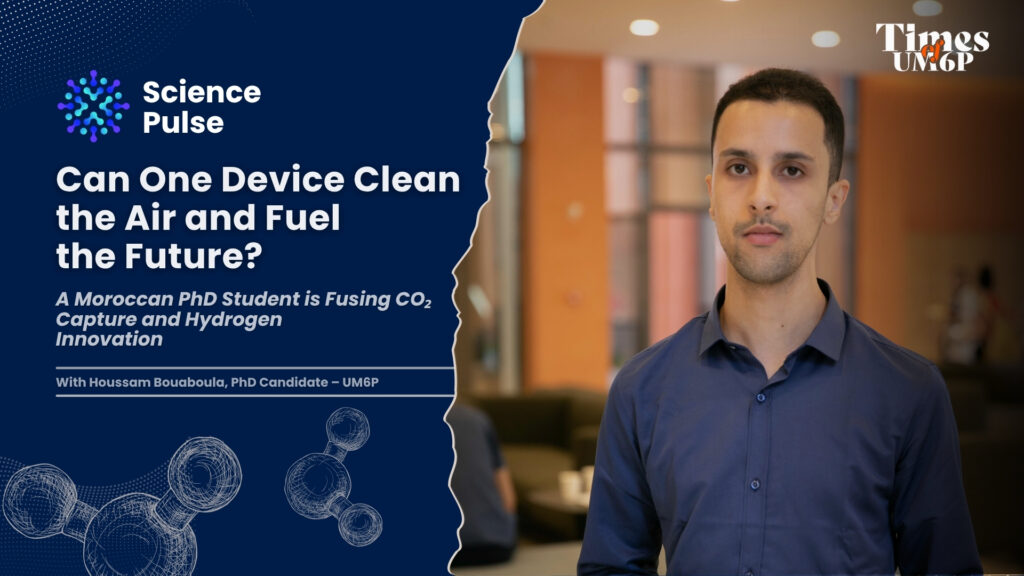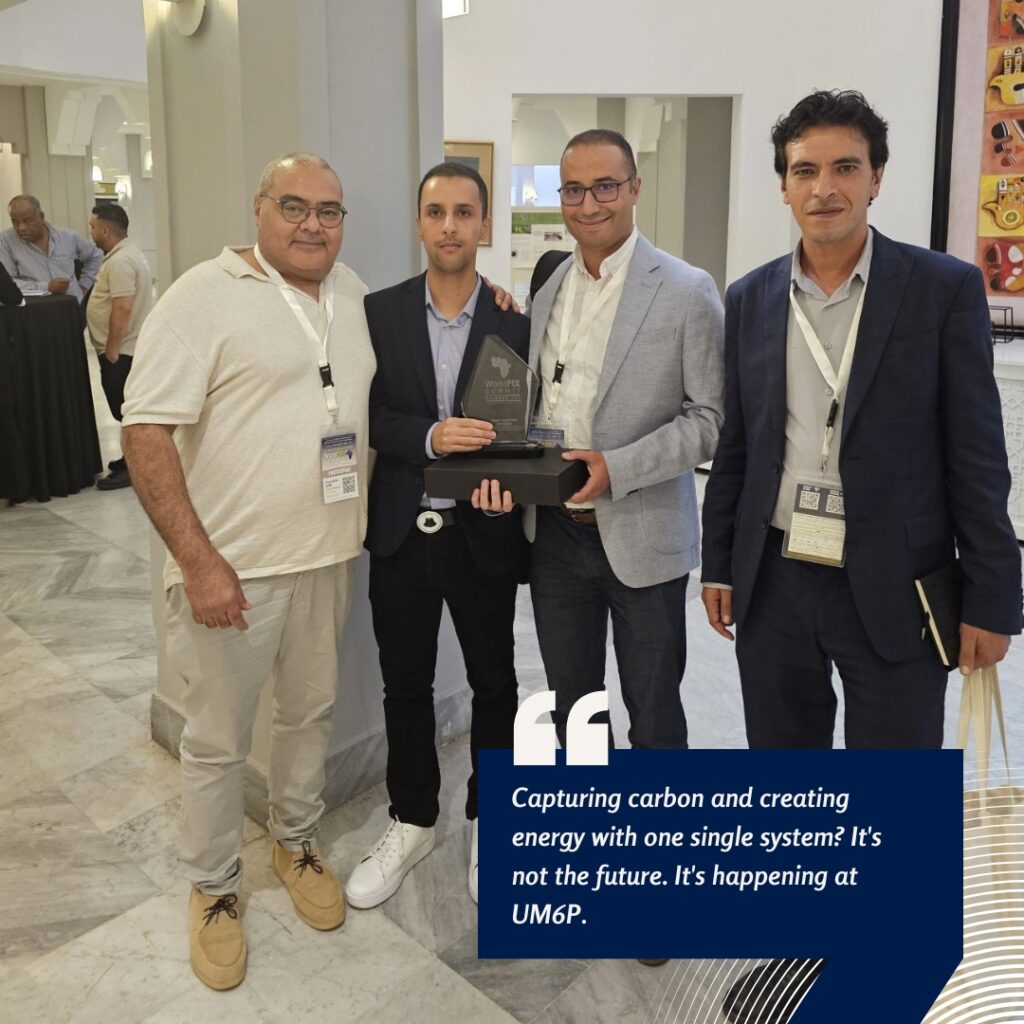Could one technology solve two of the planet’s biggest problems?
Science Pulse | By Times Of Um6p
Houssam Bouaboula, PhD candidate at UM6P, believes so and is working on developing an innovative electrochemical device that captures CO₂ and produces green hydrogen simultaneously, unlocking new prospects for Africa’s sustainable industrial growth.

In the urgent race to combat climate change, the dual challenges of reducing carbon emissions and transitioning to clean energy have often been treated as separate battles. But what if the solutions could be merged into a single, more efficient system?
That’s the vision driving Houssam Bouaboula, a PhD candidate at UM6P, under the supervision of Professors Youssef Belmabkhout and Abdelghafour Zaabout, whose research combines CO₂ capture with green hydrogen production. A synergy that could accelerate the world’s path to net-negative emissions. It is a project driven not just by science, but by vision. “From the beginning,” Bouaboula says,
“My interest was always in finding climate solutions that go beyond neutrality. What if hydrogen could be not just clean but carbon-negative?”
This single, simple question sparked a four-year journey that led to a peer-reviewed publication in the Chemical Engineering Journal and presentations from Marrakesh to Montreal.
The innovation? A compact, modular system that captures carbon directly from the atmosphere while producing green hydrogen using renewable energy. A system that could make decarbonization economically compelling, even in resource-constrained regions.
The Dual Challenge: Energy and Emissions
Net-zero by 2050 is the benchmark around which most climate scenarios now converge. The International Renewable Energy Agency (IRENA) estimates that 90% of the world’s electricity can and should come from renewable energy by 2050. But the remaining 10% will depend on carbon removals and substitutes for fossil-based fuels in hard-to-abate sectors: steel, cement, aviation, and shipping.
Green hydrogen is often cited as a candidate for this role. Yet its production remains energy-intensive, and its scalability is uncertain. At the same time, direct air capture (DAC) is limited by high energy demand, material degradation, and cost structures.
Bouaboula’s approach is to integrate both processes into a single, streamlined system. By bringing hydrogen production and CO₂ capture under one roof, he turns two expensive processes into one unified solution.

The system modifies a conventional water electrolyzer, introducing a dual environment (acidic and alkaline) that enables simultaneous CO₂ desorption and hydrogen production. This pH-swing mechanism reduces energy losses, simplifies integration, and enables a compact configuration for fuel generation.
Unlike traditional DAC, the system uses electricity alone, allowing direct use of renewable energy and avoiding fossil detours. It supports modular deployment, scalable for decentralized industrial contexts, particularly in African nations. It enables carbon-negative fuel options using local solar or wind energy.
A Fusion of Two Problems into One Solution

The pH-swing electrochemical system uses a modified water electrolyzer to generate green hydrogen and capture CO₂ using shifts in acid/base environments.
The process:
Combines DAC with water electrolysis
Absorbs CO₂ into hydroxide, then desorbs at low pH in the anode
Regenerates hydroxide and produces hydrogen at the cathode
The result: a closed-loop system that removes CO₂ while generating useful fuels
Economic Edge: The Power of Integration
The financial rationale is as important as the scientific one. For any climate technology to succeed at scale, its economic model must be robust enough to attract investment, withstand market volatility, and deliver long-term cost efficiencies. Bouaboula’s integrated approach does not only lower emissions; it also lowers the barrier to entry.
Standalone systems for DAC and hydrogen production each require dedicated infrastructure—two separate capital-intensive facilities, each with its own balance sheet of energy costs, operational overhead, and maintenance complexity. Bouaboula’s model consolidates these demands into one streamlined system.
His findings indicate cost reductions exceeding 25% per ton of CO₂ removed, especially in configurations that rely on direct air capture, where thermal desorption becomes economically unfeasible at scale.
At the current pilot scale, carbon removal costs are estimated between $84 and $132 per ton, depending on location, electricity cost, and system configuration. These figures may seem steep, but the model suggests they are highly elastic: with access to low-cost renewable power and optimization of membrane performance, those numbers could fall below the critical $50 per ton threshold.
That threshold, often cited by investors and climate policymakers, marks the point at which DAC begins to look viable not just as a mitigation strategy but as a business proposition.
The hydrogen economics are equally compelling. When carbon credits or offsets are taken into account, the system’s ability to deliver competitively priced hydrogen is enhanced.
Based on current projections, the model achieves price competitiveness when electricity can be sourced at rates below $40 per megawatt-hour, and hydrogen can be sold in the $4 to $7 per kilogram range—a target that increasingly aligns with trends in global green hydrogen markets. These price points are particularly attractive in jurisdictions where carbon pricing mechanisms or climate-linked procurement programs are in effect.
Furthermore, the dual output of hydrogen and captured CO₂ creates potential for downstream value creation. Captured carbon can be fed into synthetic fuel loops—methanol, formic acid, or ammonia—or even used in building materials and green chemistry. Each of these avenues opens new revenue streams and hedges risk, making the system more attractive to both industrial adopters and early-stage investors. In this way, Bouaboula’s work is not just a scientific demonstration, but a financial proposition for a new kind of energy infrastructure. One that pays for itself, not just in environmental terms, but in real, measurable value.
The African Lens: Morocco and Beyond
What makes this research particularly relevant is its context.
Morocco has committed to reducing its emissions by 52% by 2030 and is positioning itself as a continental hub for green hydrogen. Yet, as Bouaboula notes, carbon capture is still lagging in policy and investment.
Is to bring both technologies under the same roof, so the momentum for hydrogen can help pull CO₂ capture forward.
Houssam Bouaboula, PhD Candidate – UM6P
In Africa, where energy infrastructure is often sparse and industrial emissions are rising, this kind of modular, renewable-powered system could unlock decarbonization without requiring megaprojects. Think remote cement plants, off-grid hydrogen hubs, or even community-scale fuel production for transport.
“Scale matters,” Bouaboula concedes. “But flexibility matters more. If you can plug into a solar panel and capture carbon while making hydrogen, suddenly the whole narrative shifts.”

Leave a Reply